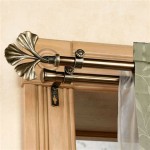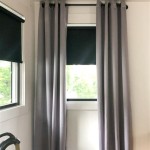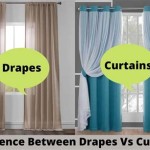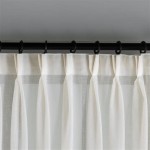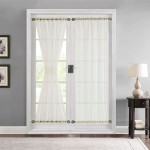What Size Shower Curtain For a Standard Tub?
Selecting the correct size shower curtain is crucial for maintaining a clean and aesthetically pleasing bathroom. A properly sized shower curtain prevents water from escaping the bathing area, protects the bathroom floor from moisture damage, and contributes to the overall decor. When dealing with a standard-sized tub, understanding the typical dimensions and the nuances of shower curtain sizing becomes essential. This article will delve into the appropriate shower curtain measurements for standard tubs, factors influencing the ideal size, and tips for accurate measurement to ensure optimal functionality and appearance.
Understanding Standard Tub Dimensions
The first step in determining the appropriate shower curtain size is to understand the dimensions of a standard bathtub. While variations exist, standard bathtubs in the United States typically measure 60 inches (5 feet) in length and 30 inches in width. The depth of the tub can vary, but it generally ranges from 14 to 16 inches. These dimensions serve as a baseline for selecting a suitable shower curtain. The length of the bathtub is the most critical dimension for shower curtain width, while the height from the top of the tub to the shower rod dictates the necessary curtain length.
It is crucial to acknowledge that these are average dimensions. Some variations exist, including alcove tubs, corner tubs, and freestanding tubs, each requiring consideration of specific measurements. However, for the purposes of this discussion, the focus remains on the standard alcove tub, which is the most common type found in residential bathrooms.
The Standard Shower Curtain Size: 72x72 Inches
The most widely recommended shower curtain size for a standard tub is 72 inches wide by 72 inches long. This size offers adequate coverage for the typical 60-inch tub length, allowing for some overlap on either side to prevent water leakage. The 72-inch length is designed to reach from the shower rod to just above the floor, minimizing water splashing and preventing the curtain from dragging on the floor, which can lead to mildew and damage.
The 72x72-inch standard size is readily available from numerous retailers in a wide range of materials, colors, and patterns. This accessibility makes it a convenient choice for most homeowners. However, it is critical to assess the specific installation height and the surrounding bathroom layout to ensure this standard size truly fits the unique needs of the bathroom.
Consider the shower rod height. Most shower rods are installed approximately 75 to 78 inches from the floor and the standard 72-inch length allows for a space for the air to circulate between the bottom of the curtain and the floor. This is important to prevent mold and mildew from growing. If the shower rod is placed much higher or lower, adjustments to the curtain length might be necessary.
Factors Influencing Shower Curtain Size Selection
While the 72x72-inch size is generally suitable, certain factors can influence the optimal shower curtain size. These include the height of the shower rod, the presence of a shower curtain liner, and personal preferences regarding the curtain's appearance and functionality.
The height of the shower rod is perhaps the most important factor. If the shower rod is installed significantly higher than the standard height, a longer shower curtain might be needed to prevent water from escaping. Conversely, if the rod is lower, a shorter curtain might be preferable to avoid dragging on the floor.
The use of a shower curtain liner also affects the required length. A liner is typically used in conjunction with a decorative shower curtain to provide an extra layer of water protection. Liners are usually shorter than decorative curtains to prevent them from being visible below the outer curtain. When measuring for a shower curtain, consider the combined length of the curtain and liner to ensure neither is too long or too short. A standard liner size is typically 70x72 inches, so the main curtain should be a bit longer than that to achieve the desired look.
Personal preferences also play a role. Some individuals prefer a shower curtain that hangs closer to the floor for added privacy and water protection, while others prefer a shorter curtain for aesthetic reasons. The desired level of fullness or gathering of the curtain can also influence the width. A wider curtain will create more folds and a fuller appearance when the curtain is closed.
How To Measure For The Correct Shower Curtain Size
Accurate measurement is essential for selecting the correct shower curtain size. The following steps provide a guide for measuring the shower area and determining the appropriate curtain dimensions.
First, measure the width of the bathtub or shower opening. This measurement is taken from wall to wall, or from the edge of the tub to the opposite wall if the shower is enclosed on only one side. Add approximately 12 inches to this measurement to ensure adequate overlap and prevent water leakage. For instance, if the opening is 60 inches wide (standard tub), the shower curtain width should be at least 72 inches. For a wider opening, you may need a wider shower curtain, such as 78 inches or even 84 inches.
Next, measure the height from the shower rod to the desired bottom edge of the curtain. This measurement will determine the required length of the shower curtain. Consider the distance from the rod to the top of the tub surround, or the floor if there is no surround. Account for the shower curtain rings or hooks, which will add to the overall length. If using a liner, measure from the rod to where you want the liner to end. As a general guideline, the shower curtain should hang approximately 1 to 2 inches above the floor.
It's also important to consider the type of shower curtain rod. Curved shower rods, for example, extend further into the bathroom than straight rods, which can affect the required curtain width. In such cases, a wider curtain might be necessary to provide sufficient coverage.
Addressing Common Shower Curtain Size Issues
Even with careful measurement, certain issues can arise when installing a new shower curtain. These issues often relate to incorrect sizing or improper installation techniques. Understanding these common problems and their solutions can help ensure a successful outcome.
One common issue is a shower curtain that is too short, resulting in water leaking onto the bathroom floor. This problem can be resolved by either lowering the shower rod or purchasing a longer shower curtain. If lowering the rod is not feasible due to plumbing or aesthetic considerations, opting for a longer curtain is the better solution. Some retailers offer extra-long shower curtains specifically designed for high ceilings or elevated shower rods. A size like 72x84 or 72x96 inches is a possible solution, depending on the height of the shower rod.
Another frequent problem is a shower curtain that is too long, causing it to drag on the floor and potentially develop mildew. This issue can be addressed by raising the shower rod or hemming the curtain to the desired length. Hemming a shower curtain can be a simple DIY project, or it can be outsourced to a tailor or seamstress. Using a shower curtain liner can also help to protect the decorative curtain from moisture and mildew.
A shower curtain that is not wide enough can also lead to water leakage. Ensuring adequate overlap on either side of the shower opening is crucial. If the curtain is too narrow, consider purchasing a wider curtain or using two curtains to provide full coverage; however, using two curtains is often more of an aesthetic choice rather than a practical one.
Shower Curtain Materials and Their Impact on Size
The material of the shower curtain can also influence how it hangs and performs, indirectly affecting the perceived size and effectiveness. Different materials have varying weights, drape differently, and react differently to moisture, all of which should be considered in the selection process.
Polyester shower curtains are a popular choice due to their durability, water resistance, and ease of cleaning. Polyester tends to drape well and doesn’t shrink easily, maintaining its intended size. Vinyl shower curtains are also water-resistant and easy to clean, but they can be stiffer and less aesthetically pleasing than polyester. Fabric shower curtains, such as cotton or linen, offer a more luxurious look and feel but require a shower curtain liner to protect them from water damage. Fabric curtains can also shrink slightly after washing, so it's advisable to choose a size that allows for some shrinkage.
The weight of the material can also affect how the curtain hangs. Heavier materials tend to drape more smoothly and provide better water protection, while lighter materials can be more prone to billowing and water leakage. Consider using weighted shower curtain rings or magnets to help keep the curtain in place and prevent water from escaping.
Alternatives to Standard Sized Shower Curtains
While the 72x72-inch shower curtain is the standard size for a typical bathtub, there are instances where alternative sizes or styles might be more appropriate. These alternatives address specific bathroom layouts, design preferences, or functional requirements.
For bathrooms with particularly high ceilings, extra-long shower curtains are available in lengths ranging from 84 to 96 inches. These curtains provide adequate coverage and prevent water from escaping, even with elevated shower rods. Similarly, for smaller bathrooms or showers with limited space, narrower shower curtains might be necessary to avoid overcrowding. Specialty retailers often offer custom-sized shower curtains to accommodate unique dimensions.
Shower doors are an alternative to shower curtains. Shower doors are available in various styles, including sliding doors, pivot doors, and folding doors. Shower doors offer a more permanent and watertight solution compared to shower curtains, but they can be more expensive and require professional installation. A neo-angle shower (corner shower) may be another alternative that could change required shower curtain sizes or the need for a shower curtain altogether.
Maintaining Shower Curtain Size and Condition
Proper maintenance of a shower curtain is essential for preserving its size, appearance, and functionality. Regular cleaning and care can prevent mildew growth, prolong the curtain’s lifespan, and ensure it continues to provide adequate water protection.
Shower curtains and liners should be cleaned regularly to remove soap scum, mildew, and other debris. Polyester and vinyl curtains can typically be cleaned by wiping them down with a damp cloth and mild detergent. Fabric curtains can often be machine washed, but it's important to follow the manufacturer’s instructions. Adding a cup of vinegar to the wash can help to remove mildew and odors.
Allowing the shower curtain to dry completely after each use can also help to prevent mildew growth. Spread the curtain out fully to allow air to circulate and dry any moisture. Consider using a squeegee to remove excess water from the curtain after showering.
If the shower curtain develops significant mildew or becomes damaged, it might be necessary to replace it. Regularly inspecting the curtain for signs of wear and tear, such as rips or tears, can help to identify when replacement is needed. By taking proactive measures to maintain the shower curtain, homeowners can ensure it continues to provide effective water protection and enhances the overall appearance of the bathroom for longer.

Most Popular Shower Curtain Sizes Measuring Tips

Choose The Correct Size Shower Curtain

Liba Fabric Shower Curtain White Heavy Duty Water Repellent Soft Cloth Hotel Style Curtains

Choose The Correct Size Shower Curtain

At What Height Should A Shower Curtain Be Installed Gerwerken Crafts

Riyidecor Clawfoot Tub Chevron Shower Curtain Bathtub All Wrap Around

Shower Curtain Sizes Standard Dimensions Measurement Tips More Zameen Blog

The Best Shower Curtain For Your Bathroom Home

What Size Is A Standard Shower Curtain Choosing The Best Fit For Your Bathroom

What Is The Standard Shower Curtain Size Society6


